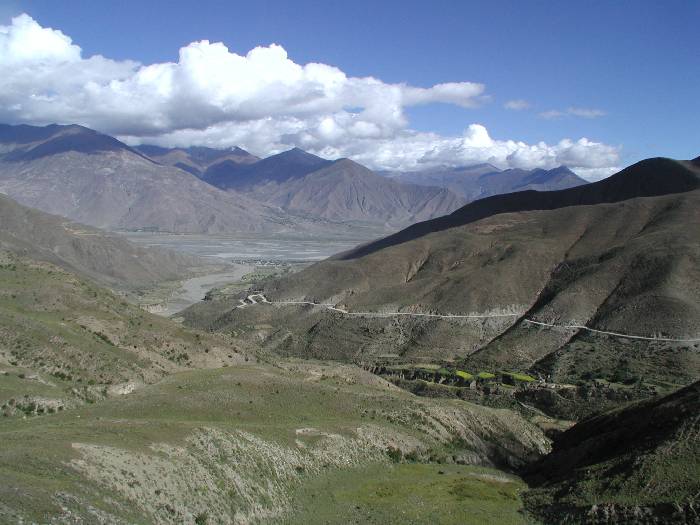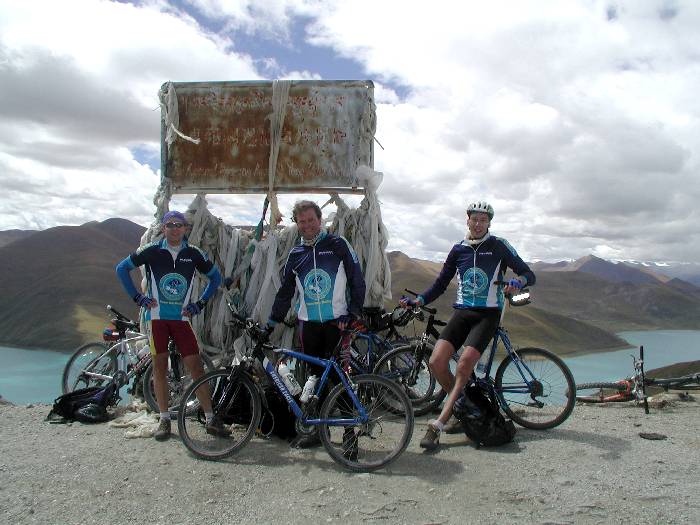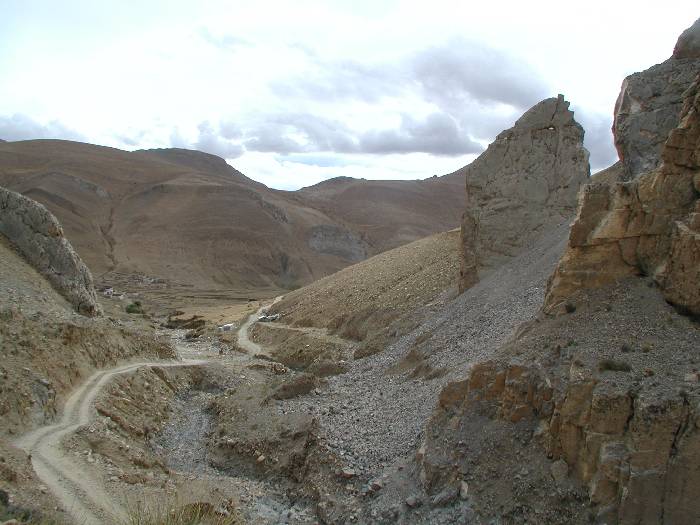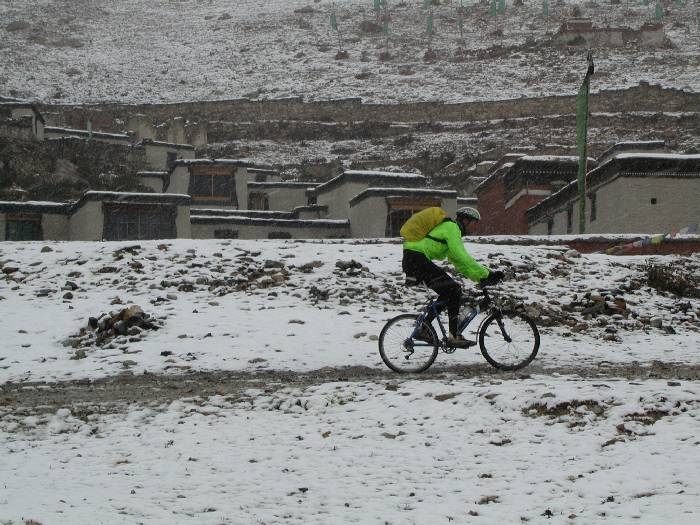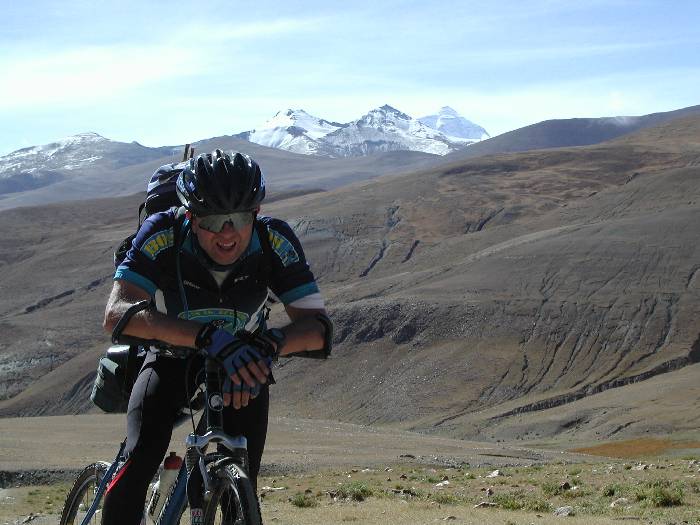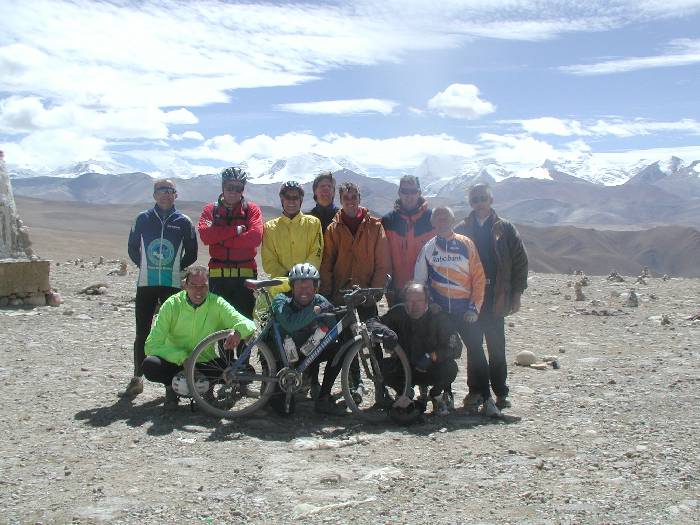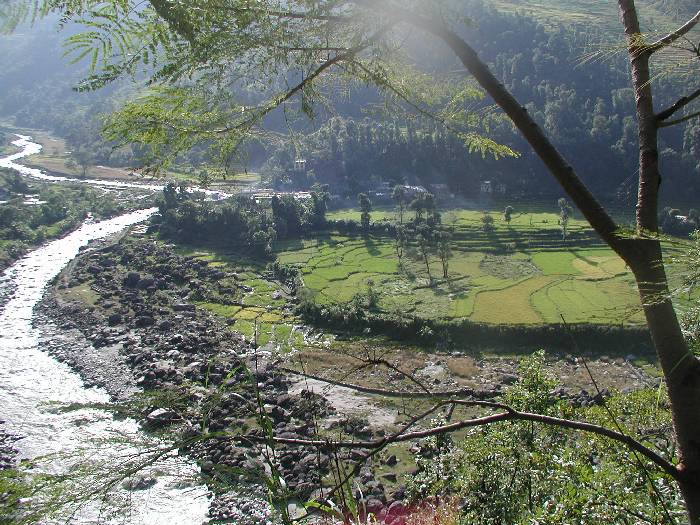Tibet by Bike

Cycling in Tibet is hard. Why would someone who considers himself to be a quiet normal family man go cycling in such a country. Or more precisely, why would anyone go cycling there at all.
Most people do not know much about Tibet other than that it is rather high up and far away, and so it is. We knew more about this 'roof of the world' than most before we went, but fortunately not everything. But let's start at the beginning; who are we and why did we want to go to Tibet in the first place!
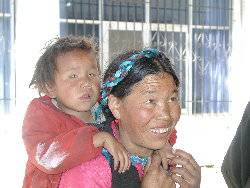
Mother
and child at the gate of Project for the Blind
This expedition started like many travels with a casual remark while drinking a beer with cycling friends. You should know that for more than fifteen years our rowing team has done some voluntary cycling in the European mountains and to supplement the loss of moisture we would drink a beer now and then. And while we were telling each other heroic cycling stories someone would come up with a brilliant plan. Some of those plans have, from what we remembered the day after, been worked out and a few have even been executed.
What we normally did was thinking of a nice place to go for a week and cycle as much as we could. You might think that over the years those weeks became more like holidays and less like cycling up and down the mountains but that is not the case.
You could even say that we have become more crazy (about cycling) and after cycling almost every interesting pass in Europe we ended up at Everest. At the Base Camp of Everest that is.
But why Tibet? There is not a simple answer to that simple question, but perhaps you will understand at the end of this story.
One reason is that in Tibet the mountains are higher than in Europe. For us that is quite a good reason because we are mountain-pass collectors (I will tell you more about that later). Another good reason is: if we want to do something special we must do it now for we are not getting any younger. I decided to do it this year because I celebrated my 50th birthday this year. And what about these reasons: they say it is beautiful in Tibet; we like to sweat it out; we have not been there before; etc.
The best answer is probably that you should not ask that kind of question - it is just a good idea that needs no excuse.
But only cycling in such a poor country seemed a poor plan, until we found a perfect sponsor project and then our plan was perfect.
Project for the Blind
In May 1998 the first school for the blind in the Tibet Autonomous Region (T.A.R.) opened. Six eager children between 6 and 12 began to learn how to read and write the Tibetan Braille script. This represented the first small step in a project for the blind in Tibet. It was the start of a rehabilitation and training centre that aims to give blind people a chance to participate in society.
This centre consists of four major projects:
1.
Implementation of a preparatory school for blind children.
2. Production of educational materials for the blind.
3. Preparation of a re-integration program facilitating the return to local
schools and home life for the children.
4. Realisation of vocational training which gives blind people an opportunity
and skills to generate their own income.
The goal is to realise all four projects within the next four years and to hand them over to the local staff and the Tibetan Disabled Person's Federation. TDPF will then take over the responsibility for continuity of the project. http://www.ropacomputer.nl/Tibet/Tibet_en.html
We decided that we would try to collect as much money as we could and that all of it would be for the project. This seems very logical but later on we heard stories about 'sponsor projects' that turned out to be a collection of money for the journey itself and not for the good cause.

From
left to right: Sikko, me, Max and Willem Vermeend
To give the project a good start we invited the Dutch minister for social affairs Willem Vermeend, to join us in our first training tour of the year, a 120 km. return trip to a place called Ommen. An important attraction of this tour was always drinking coffee and eating a variety of pies in Ommen. Unfortunately Willem Vermeend had to cancel the tour and the pies at the last moment.
Later on he made up for this by inviting us at the ministry and autographing our banner. You probably ask yourself how we got to know him well enough to invite him for our tour, and the answer is that we did not know him well at all. We just met Willem at another cycling event the year before (he is an enthusiastic cyclist) and just asked him if he would like to join us sometime. Some things in life are easier than they seem.
Lots of decisions had to be taken after we had convinced ourselves, our families and some of our friends. A small company called Wout Conijn Reizen had organised a similar journey before, and if there were enough others crazy enough to join, Wout would organise our expedition. Throughout I refused to call it a holiday and I was right, it was not.
The general idea was that we would fly to Lhasa, the capital of Tibet, and then cycle to Kathmandu the capital of Nepal. Quite a simple plan, except that cycling 1100 km at altitudes of between 4000 and 5000 meters and several times even higher than that did not seem simple to us, and it was not. But then again, if we wanted to be lazy we could have gone to the beach.
We supposed that quite a lot of training would be involved but had no bicycles, that is to say, not the right kind of bicycles. Normally our group uses racing bikes to climb the European passes and we were quite certain that they would not stand up to the Tibetan treatment. Selecting and buying an All Terrain Bike was part of the fun and we made the most of it. We discovered that we had quite a lot to buy to be able to survive in Tibet and some of us were lucky enough to receive some unexpected money (inheritance). And then the training could start and that appeared to be another source of fun. If you are not used to it, riding through the forest can be very funny. Especially when your teammate rides through the mud and falls into a quagmire. Yes our humour can be very basic; the more tired we are the more basic it becomes.
Satellite
Part of the sponsoring project was our publicity plan and it turned out to be a major project in itself in the end. Again the idea was rather simple: I would send regular accounts of our experiences direct from Tibet by satellite. To some people going to Lhasa and cycling through the country probably seems adventurous enough and they are right of course. But this idea of informing the sponsors on an everyday basis so that they would feel what we felt (so to speak) and could watch our little triumphs, had something exciting to it. I knew that I was taking a great risk by informing hundreds of people before I even knew if all the equipment would do what it was supposed to do. Telephones, solar panels, digital cameras and especially computers tend to stop working at the most crucial moments and they do so in any clean office with lots of power sources around. What to think of bringing it all past dozens of very suspicious customs officials (we travelled the week after the 11th of September!) hundreds of poor Tibetans and a thousand kilometres in a truck on the roughest roads on earth. And then again, would the connection come through. I hoped and expected it would, but I am a very optimistic person (and happened to be right this time).
Our group had grown to twelve and we were an extremely diverse bunch; a very nice bunch though. The day of departure started with sad news; one of our best friends decided he could not come with us. And one hour later the travel agency called to tell that not all of our bikes could come. This was rather strange for we had told them six months ago that we would bring our bikes because we were going to cycle over there.
At the airport it appeared just to be a trick to make us pay more for our bikes. Other minor problems were all the new security measures, which took lots of time. We had to leave a pair of nail scissors behind. We were not allowed to bring them, not even in the cargo space.
Altitude
Flying to Kathmandu was easy enough, although landing in a desert in the middle of the night and my sleep and then getting out of the plane was not really pleasant. During the flight we got a foretaste of eating unpalatable meals at high altitude.
Although Kathmandu is an exciting city I will go on directly to tell you about Tibet and perhaps later return to Kathmandu, as we did by bike.
Arriving at Lhasa airport came with two surprises: the altitude, of more than 3600 m. and the distance to Lhasa of 90 km. The air at the airport was sparkling and the surrounding mountains did not look too high, until I realised at what altitude I was already standing. They were all higher than we have in Europe. The highest pass in Europe is the Bonette in the French Alps which is not even 2800 m.
As I said before the pass collectors among us are very keen on (you might even say obsessed by) high altitude passes, and we were feeling like children in a chocolate factory. Later on there were times that we felt like the boy, in one of Roald Dahl's other stories, who had eaten too much.
We were warned about the first days in Tibet because altitude sickness can easily strike and sometimes even kill you. Just walking up the stairs in our hotel did not kill us but made clear that we should take it easy, at least during those first days in Lhasa. This amazing city with its towering Potala Palace, broad avenues and intriguing Barkhor market area. Large parts of Lhasa look like the Chinese cities I have seen on TV (and that is what they are: Chinese) but there are still some interesting Tibetan areas too where time does not seem to have moved and people show that they have not forgotten all about the old way of life. Especially around the ancient temples like Sera and Jokhang you will find an atmosphere of worship (and the smell of yak-butter-candles) that is very impressive.
Pilgrims prostrating themselves to the ground, monks moving around in their red habits and the smoke of incense drifting around the square.
Of course we also climbed the hundred meters high stairs of Potala Palace, though not on the first day, and wandered through some of its one thousand halls. From the roof you have a splendid view of the city, the valley and the surrounding mountains and to the west we could see the river Kyi Chu and the road we were longing to cycle into the hazy mountain ranges.
Departure
The first stage of our cycling expedition was to be easy enough. Although an altitude of more than 3600 m. was higher than we ever cycled, the road was smooth and flat and even going down along the majestic Kyi Chu river. Some of us thought that this was an invitation to ride at speeds of forty and more but they were punished immediately because they missed the guesthouse and were lost for some time.
About guesthouses I will tell you more later on but the foretaste we had at Chushul was not easily forgotten. Two of the hardships of this journey would be the nights and the lack of sanitary facilities. That was immediately clear. Fortunately we did not know yet how bad the roads were going to be and what the lack of good food, or the absence of appetite, would do to our stamina.
The next morning however we were as ready as we could be to climb our first pass, a mere 4800m, but a good one to start with. As soon as you have passed the bridge over the upper course of the river Brahmaputra, you know that it will not be easy. That is where the tarmac stops and the dust begins. Only 15% of the road ahead was going to be good enough to ride with a racing bike. Forty percent is good enough for a normal car, although the car would not last very long, and another thirty percent is just good enough to ride with an ATB. The last 15% is not good enough for anything but goats, but we did it just the same. As I said: fortunately we did not know yet what was to come. Nevertheless the first pass was not too difficult and the views from the top are fantastic. Far below is the great lake Yamzho Yumco with its amazing ever-changing colours. We met with our first headwind and hailstorm and with much uncertainty about the distance to, and location of, our next guesthouse.
Achievement
It was in this guesthouse that I suffered from my first attack of pneumonia when I got out of bed the next day. Dressing was hard enough and climbing the Karo La (La = pass) was unforgettable. Crawling along I promised myself a stop every 100 meters (altitude) and it worked. I came to the top at 5010 m. in the end and also descended for a while, but later that day my light went out and for the first time in my life I had to leave a stage unfinished. Climbing into the back of our truck was by no means the end of my agony however. On roads like that the only pleasant moments are those when you sail through the air together with the bags and bikes around you. Coming down the next moment is rather uncomfortable, especially when this is repeated hundreds of times.
In the end there was a rather dusty campsite and while I fell in a deep sleep that lasted twelve hours, my friends built a tent around me. However, just a few days later happened to be time for revenge as I recorded my best achievement ever, the non stop climb of what is probably the highest pass on earth, the 5250 m. Gyatsho La (or Lhakpa La = wind pass).
Meanwhile some of the other team members were having their own problems and triumphs. One well-trained friend even had to decide to break off the journey and return to Lhasa because of altitude sickness. For some of the others the road from Gyantse to Shigatse turned out to be a real killer. We expected this road to be one of the easiest stretches, but as it happened Tibetan men, women and children were turning this road into a disaster. People in high places had decided that this road should be improved and that this should be done all (90 km) at the same time. There will be improvements, no doubt about that, but not this year.
Brothel
When I said that I would tell you more about the guesthouses, this is one of the little stories I had in mind.
They surprised us in different ways. Sometimes they were depressing, with their lack of tap water, decent toilets and safe food. Other times they were great fun.
One day we were cycling along and as we had agreed to camp, the leading group searched for a suitable campsite. We found a superb site close by the river with lots of fresh air and no dogs, children or karaoke lovers in sight. You should know that for several nights karaoke and / or dogs had kept us awake and that we are fond of children but not when they crowd us or throw stones at us.
But anyway it was a fine site and we were rather annoyed when our Tibetan guide said that we should not camp here and that he knew a splendid guesthouse nearby. We knew something about his 'splendid guesthouses' and his knowledge of distances but agreed to have a look (by car). One of us went along and came back quite satisfied with what he had seen and 'it was only eight kilometres more to go'. We did not like that much after a day of more than 100 km. but in the end agreed.
After 12 km. the only building that came in sight was the saddest place I had seen in days but the welcome was warm enough and several young women started making our dinner and serving drinks with gratifying haste. Although I wondered how such a remote guesthouse could employ such a number of girls just for cooking and serving at table I was too tired to draw the obvious conclusion. Next morning however, when the guide was sleepy but in very good mood it dawned upon me that we had slept in a brothel.
I was very sleepy too but for another reason. Sleeping high in the mountains normally gives me some trouble because my heart and breathing take their time to get used to the unusual circumstances. But this night was much worse. For hours I tried to fall asleep and every time I almost succeeded, my breath would stop. Probably not for long but at an altitude of 4500 m. or more a few seconds is long enough to wake you up with a definite lack of oxygen. Later on, at the slopes of Mount Everest, it became clear that even making photographs (while holding your breath) could kill you if you take too many in a row.
For several hours I tried to regulate my breath but it was no use and a fearful experience. Now I knew how asthmatic people must feel. In the end I woke my friend (the general practitioner) to ask him for a sleeping pill and he earned my eternal gratitude when he agreed. My first night in a brothel and I asked for a sleeping pill !
Everest
If we thought the worst roads were behind us, then Pang La proved us wrong. Especially the first part of the climb was HR (Hors Catégorie) and the word 'road' not very appropriate. But we were getting very near Chomolungma, as the Tibetans call Mount Everest. This made us excited enough to conquer any pass, if necessary on our knees. One more guesthouse in a place called Taschi Dzong where a thousand dogs made it anything but a rest house and we would be there.
At dawn on the fifth of October we expected a not so difficult climb rising slowly along the river to Rongbuk Monastery at 5000 m. But again we were wrong, although not about the climb. This time it was the weather that made the difference. The road was not too bad, nor was the climb, there was not even much wind and for the first time in days no dust! But the reason for the latter was that the rain had set in, only to make room for snow when we were gaining height.
As Rongbuk came into sight we were half frozen and had not seen any mountain, not even Everest. The monks of the monastery welcomed us warmly by leading us to a very dark and smoky room to sit next to the stove that was immediately refilled with dried yak-dung. I was so cold that I even dared to ask for the hot yak-butter-tea that they were preparing. It is the national drink and has little to do with tea, it tastes more like broth. But to me it had a heavenly taste and so it should in the highest monastery on earth. It is made with yak-butter, salt, soda and tea. Someone told me that it takes time to learn to appreciate this famous broth but that it is not clear how much hardship you need to do so. Well I had discovered just how much.
Outside the monastery the weather had not improved and that was very disappointing. One of the main reasons to have come this far was the fame and splendour of Everest but what we saw were grey clouds and snow and very cold sleeping halls.
Perhaps our visit to the monastery and the money we left there had an impact on the weather conditions, who knows. Fact was that later that afternoon it improved and we decided to visit Base Camp right away, before it would deteriorate again.
We were very lucky. As soon as we arrived we could see Everest through the clouds and within half an hour it was there before us in all its splendour.
We went out of our minds; laughing and strolling around and taking hundreds of pictures. Our condition will have been influenced by the lack of oxygen that tends to make someone act a bit funny. It did almost knock me off my feet though when I tried to make several pictures in a row and forgot to breathe.

Base
Camp, 5 October 2001
As we were in a hurry all the time we could not stay another day to worship Chomolungma. We were very anxious to know if we could take the short cut and some were very anxious not to climb that horrible Pang La again. Our decision to take the short cut and the fortunate coincidence that the river was low enough to pass brought us to an amazing stage in our voyage, already full of amazing events.
The river was an interesting test and it proved that most teammates were afraid of wet feet. Later on everyone got wet feet plus a very dry throat. We had lots of dust again and strong winds, but for once not only head winds, and the most fantastic scenery we had ever seen. And at the end of this stage (that made a difference of one day) we even had a hot shower and electricity for my satellite report to the home front.
One more climb brought us to Lalung La (5050 m) our last pass in Tibet and the starting point for one of the longest descents on earth. One hundred and sixty kilometres and more than 4500 meters altitude descent were lying ahead of us and we did not mind. After all the climbing we had done so far on unprecedented rough roads, we were longing for some easy cycling. Well it turned out that all the cycling we had done so far had been an essential training for the first part of this descent.
Extremely rough roads, inches of dust and a very strong head wind was probably very good for our Karma but not for our mood. We survived, but only just.
The scenery was again magnificent and the difference between the start of that day and the end could not have been greater. From mountain climate and strong desert winds we dived into the benevolent warm atmosphere of Nepal with tropical forests, exotic smells, bright colours and noisy crickets. The people were very different too; very friendly and relaxed. The Tibetans are friendly too, and even cheerful, but always keep their distance. We left their country with mixed feelings. With great admiration for their cheerful way of dealing with the enormous hardships they face. And with our memory full of images of grand landscapes and breathtaking passes.
Epilogue
To answer my own question: why did we cycle through Tibet?
Well, we have probably proved something to ourselves but we do not know what.
Or as Buddha puts it: 'there is no way to happiness; happiness is the way'.
Pieter Parmentier N°6041 parment@wxs.nl




